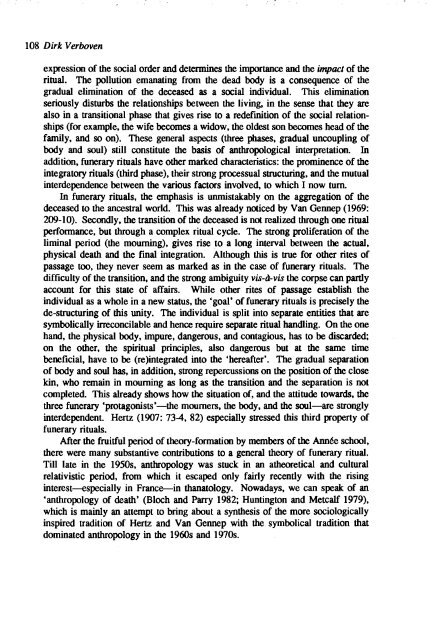1991 No. 1 CONTENTS - Institute of Social and Cultural ...
1991 No. 1 CONTENTS - Institute of Social and Cultural ...
1991 No. 1 CONTENTS - Institute of Social and Cultural ...
You also want an ePaper? Increase the reach of your titles
YUMPU automatically turns print PDFs into web optimized ePapers that Google loves.
108 Dirk Verboven<br />
expression <strong>of</strong> the social order <strong>and</strong> determines the importance <strong>and</strong> the impact <strong>of</strong> the<br />
ritual. The pollution emanating from the dead body is a consequence <strong>of</strong> the<br />
gradual elimination <strong>of</strong> the deceased as a social individual. This elimination<br />
seriously disturbs the relationships between the living, in the sense that they are<br />
also in a transitional phase that gives rise to a redefmition <strong>of</strong> the social relationships<br />
(for example, the wife becomes a widow, the oldest son becomes head <strong>of</strong> the<br />
family, <strong>and</strong> so on). These general aspects (three phases, gradual uncoupling <strong>of</strong><br />
body <strong>and</strong> soul) still constitute the basis <strong>of</strong> anthropological interpretation. In<br />
addition, funerary rituals have other marked characteristics: the prominence <strong>of</strong> the<br />
integratory rituals (third phase), their strong processual structuring, <strong>and</strong> the mutual<br />
interdependence between the various factors involved, to which I now turn.<br />
In funerary rituals, the emphasis is unmistakably on the aggregation <strong>of</strong> the<br />
deceased to the ancestral world. This was already noticed by Van Gennep (1969:<br />
209-10). Secondly, the transition <strong>of</strong> the deceased is not realized through one ritual<br />
performance, but through a complex ritual cycle. The strong proliferation <strong>of</strong> the<br />
liminal period (the mourning), gives rise to a long interval between the actual,<br />
physical death <strong>and</strong> the fmal integration. Although this is true for other rites <strong>of</strong><br />
passage too, they never seem as marked as in the case <strong>of</strong> funerary rituals. The<br />
difficulty <strong>of</strong> the transition, <strong>and</strong> the strong ambiguity vis-a-vis the corpse can partly<br />
account for this state <strong>of</strong> affairs. While other rites <strong>of</strong> passage establish the<br />
individual as a whole in a new status, the 'goal' <strong>of</strong> funerary rituals is precisely the<br />
de-structuring <strong>of</strong> this unity. The individual is split into separate entities that are<br />
symbolically irreconcilable <strong>and</strong> hence require separate ritual h<strong>and</strong>ling. On the one<br />
h<strong>and</strong>, the physical body, impure, dangerous, <strong>and</strong> contagious, has to be discarded;<br />
on the other, the spiritual principles, also dangerous but at the same time<br />
beneficial, have to be (re)integrated into the 'hereafter'. The gradual separation<br />
<strong>of</strong> body <strong>and</strong> soul has, in addition, strong repercussions on the position <strong>of</strong> the close<br />
kin, who remain in mourning as long as the transition <strong>and</strong> the separation is not<br />
completed. This already shows how the situation <strong>of</strong>~ <strong>and</strong> the attitude towards, the<br />
three funerary 'protagonists'-the mourners, the body, <strong>and</strong> the soul-are strongly<br />
interdependent. Hertz (1907: 73-4, 82) especially stressed this third property <strong>of</strong><br />
funerary rituals.<br />
After the fruitful period <strong>of</strong> theory-formation by members <strong>of</strong> the Annee school,<br />
there were many substantive contributions to a general theory <strong>of</strong> funerary ritual.<br />
Till late in the 19508, anthropology was stuck in an atheoretical <strong>and</strong> cultural<br />
relativistic period, from which it escaped only fairly recently with the rising<br />
interest--especially in France-in thanatology. <strong>No</strong>wadays, we can speak <strong>of</strong> an<br />
'anthropology <strong>of</strong> death' (Bloch <strong>and</strong> Parry 1982; Huntington <strong>and</strong> Metcalf 1979),<br />
which is mainly an attempt to bring about a synthesis <strong>of</strong> the more sociologically<br />
inspired tradition <strong>of</strong> Hertz <strong>and</strong> Van Gennep with the symbolical tradition that<br />
dominated anthropology in the 1960s <strong>and</strong> 1970s.
















